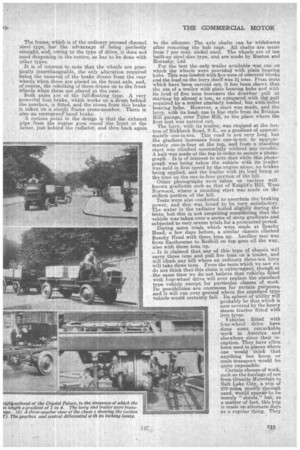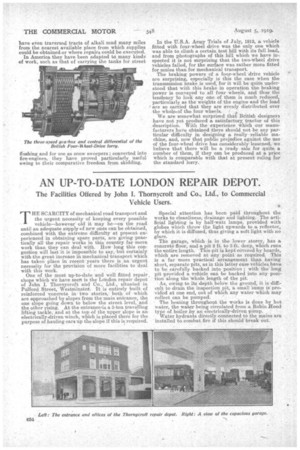THE FOUR-WHEEL DRIVE AND ITS POSSIBILITIES.
Page 10

Page 11

Page 12

If you've noticed an error in this article please click here to report it so we can fix it.
Particulars of Some Interesting Tests Conducted with a Four-wheel-drive Tractor.
IN OUR ISSUE dated July 29th was included an editorial entitled "The Field of the Four-wheel Drive," in which we stated our belief that the lorry provided, with this form of drive is the vehicle for the farmer to use in conjunction with his agricultural tractors. By this we do not imply that its operation need be restricted to this work alone, for it should also be eminently suitable for heavy work
in the building and similar trades. .
Up to the time of the commencement of the war, the four-wheel drive was not greatly favoured in Britain, but its possibilities had been fully realized by various foreign Governments, and a number of interesting vehicles were turned out by French, German and Italian constructors. Some of these vehicles were fitted with all-wheel steering, but this type has certain disadvantages when required for use in traffic and on narrow roads, as the back swings out to a certain extent when the front is steered in. Not many of these machines were built for commercial work, the majority being designed for army purposes, but they proved so satisfactory in performing their duties in this connection that designers are looking to them to cope with work which is rather too difficult for the ordinary' two-wheel drive machine to undertake.
The capabilities of the four-wheel-drive vehicle in the way of pulling heavy loads are certainly remarkable, as was shown by its wide use as a means of towing guns during the late war.
We were recently given a most interesting demonstration of the possibilities of four-wheel drive as applied to a particular chassis—that marketed by the British Four-Wheel-Drive Tractor Lorry Co, whose' –premises are at 1-3, Brixton Road, Brixton, S.W. 11.
This vehicle will shortly be manufactured in quantity by this concern, but at present the components are being supplied by various British makers—for instance, the axles are made by Wrigley, of Birmingham. The rights of manufacture have been purchased from the British Government, and the vehicle should not be confused with the American F.W.D., though it follows the American design, as it incorporates many improvements and is British-built throughout with the exception of the steering gear and magneto.
One of the chief improvements over the American model is that it incorporates a Dorman 41 b.h.p., 4 J.0. type engine, which gives rather more than this power at 1,100 r.p.m., corresponding to a speed ' on top gear of 14 m.p.h. other improvements have also been effected, in the des;gli. In many places splined shafts have been introduced in lieu of the squared type employed in the American model. Hyatt roller bearings have been dispensed with and Hoffmann roller bearings substituted.
To those persons who are not well acquainted with this particular make of lorry, a short description will not be out of place. The engine drives through..a gearbox which is situated in the centre of the chassis. The drive from this box is taken through a silent Renold chain to a central differential, and from this differential .cardan shafts convey the power to bevel gearing on the front and rear axles. Each of these axles is also provided with a differential, making a total of three for the vehicle.
To allow-for-steering, which is effected through the front wheels amily, the driving shafts operating in the front axle are provided with universal joints at the wheel' pivots. Spherical ends on the axles, and spherical casings on the front wheels prevent the ingress of dirt or water and the egress of oil. A differential lock is provided in the central easing, .operated by means of two levers, by which also the drive to either axle can be freed. The frame, which is of the ordinary pressed channel steel type, has the advantage of being perfectly straight, and, owing to the type of drive, it does not need deepening in the centre, as has to be done with other types.
It is of interest to note that the wheels are practically interchangeable,. the only alteration required being the removal of the brake drums from the rear wheels when these are placed on the front axle, and, of course, the rebolting of these drums on to the front wheels when these are placed at the rear.
Both axles are of the full-floating type. A very powerful foot brake, which works on a drum behind the gearbox, is fitted, and the stress from this brake is taken on a sturdy frame cross-member. . There is also an emergene hand brake.
A curious point in the design is that the exhaust pipe from the engine goes round the front of the latter, just behind the radiator, and then back again to the silencer. The axle shafts can be withdrawn after removing the hub caps. All shafts are made from 7 per cent. nickel steel. The wheels are of the built-up steel disc type, and are made by Ruston and Hornsby, Ltd.
For the test the only trailer available was one on which the wheels were provided with plain bearing
hubs. This was loaded with five tons of concrete blocks and the load on the lorry itself was 31 tons. From tests which have been carried out, it has been shown that the use of a trailer with plain bearing hubs and with its load of five tons increases the drawbar pull at starting by almost a ton, as compared with the pull required by a trailer similarly loaded, but with roller bearing hubs. However, a start was made, and the i lorry, with its load; ran n frac style from its Brixton Hill garage, over TuIse Hill, to the place where the first test was carried out.
The lorry, with its trailer, was stopped at the bottom of Birkbeck Road, SE., on a gradient of approximately one-in-ten. This road is not very long, but the gradient increases from one-in-ten to approximately one-in-four at. the top, and from a standing start was climbed successfully without any trouble. A halt was made at the top in order to secure a photo-graph., It is of interest to note that while this photograph was being taken the vehicle with its trailer was held in first speed by the engine alone, no brakes being applied, and the trailer With its load being at the time on the one-in-four portion of the bill.
Other photographs were taken on various wellknown gradients such as that of Knight's Hill, West. Norwood, where a standing start was made on the stiffest portion of the hill. Tests were also conducted to ascertain the braking power, and this was found to be very satisfactory. The water in the radiator boiled .slightly during the te`sts, but this is not surprising considering that the vehicle was taken over a series of steep gradients and subjected to very severe trials for a protracted period. During some trials which were made at Reachy Head, a. few days before, a similar chassis climbed . Beaehy Head with three .tons up. Another test was from Eastbourne to Red-hill on top gear all the way, also with three tons up.
It is claimed that any of this type of chassis will carry three tons and pull five tons on -'a, trailer, and will climb any hill where an ordinary three-ton lorry will take three tons. From the tests which we saw we do not think that this claim is extravagant, though at the same time we do not believe that vehicles fitted with four-wheel drive will ever replace the standard type vehicle except for particular classes of work. Its possibilities are enormous for certain purposes, and it will run over ground where the standard type vehicle would certainly fail. Its sphere of utility will probably be that which is now covered by the heavy steam tractor fitted with iron tyres.
Vehicles fitted with four-wheel drive have done some remarkable work in America and elsewhere since their inception. They have often been used in places where one would think that anything but horse or mule transport would -be quite impossible. Certain classes of work, such as the haulage of ore from Granite Mountain to Salt Lake City, a, trip of 270 miles, mostly through sand, Would:appear to be merely "stunts," but, as a matter of fact, -this trip is made on alternate days as a regular thing. They have even traversed tracts of alkali mud many miles from the nearest available place from which supplies could be obtained or where repairs could be executed. In America they have been adapted to many kinds. of work, such as that of carrying the tanks for street flushing and for use as snow sweepers ; -converted into fire-engines, they have proved particularly useful owing to their comparative freedom from skidding. In the U.S.A. Army Trials of July, 1912, a vehicle fitted with four-wheel drive was the only one which was able to climb a certain test hill with its full load, and from photographs of this hill which we have in-.
i speoted it s not surprising that the two-wheel drive vehicles failed, for the surface was rather more fitted for mules than for mechanical transport.
The braking powers of a four-wheel drive vehicle are surprising, especially is this the case when the transmission brake is used, for it will be quite understood that with this brake in operation the braking power is conveyed to all four wheels, and thus the tendency -to lock any one of them is much reduced, particularly as the weights of the engine and the load
• are so carried that they are evenly distributed over the wholpof the four wheels.
We are somewhat surprised that British designers have not yet produced a satisfactory 'tractor of this description. With the experience Which our manufacturers have obtained there should not be any particular difficulty in designing a really reliable machine, and, now that public prejudice against the use of the four-wheel drive has considerably lessened, we believe that there will be a ready sale for quite a number of them, if they can be produced at a price which is comparable with that at present ruling for the standard lorry.






















